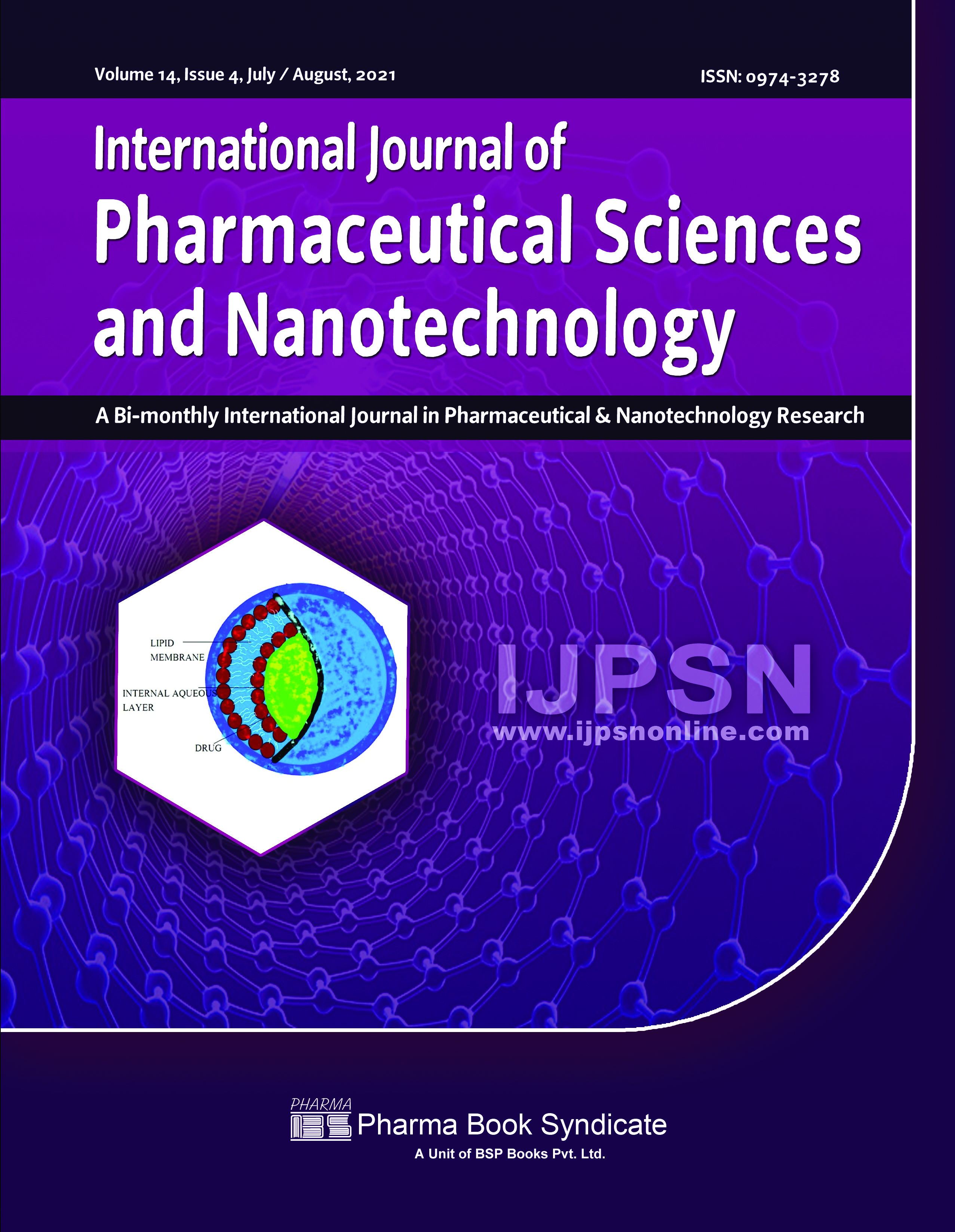Isolation, Characterization, Chemical Modification and Application of Echinochloa Colona Starch as Tablet Disintegrant
DOI:
https://doi.org/10.37285/ijpsn.2021.14.4.2Abstract
Oral disintegrating tablets are solid dosage form containing medical substances which disintegrate rapidly, usually within few seconds when placed upon tongue requiring no additional water to facilitate swallowing. Solid dosage forms that can be disintegrated, dissolved, or suspended by saliva in the mouth resulting in easy swallowing can provide significant benefits to the pediatric and geriatric population, as well as other patients who prefer the convenience of easily swallowable dosage forms Superdisintegrants are currently approached and utilized in the formulation of the orally disintegrating tablets. The present work includes isolation of starch from Echinochloa Colona and further characterizing it for various physicochemical and phytochemical analysis. The isolated starch has been modified chemically and its disintegrating efficiency has been tested in tablet formulation; the present work also explores the optimization of concentration of starch in formulation of Ibuprofen tablets in comparison with synthetic and natural superdisintegrants. Phytochemical analysis confirmed the presence of starches and carbohydrates. Results indicated that the Echinochloa Colona starch samples could be potential superdisintegrants in orally disintegrating tablets of Ibuprofen. Tablet performance was found to influence by the way of addition of starch, its concentration and the method of tablet preparation. From these results it is possible to conclude that Echinochloa Colona starch could be used as a superdisintegrant.
Downloads
Metrics
Keywords:
superdisintegrants, Ibuprofen, Echinochloa Colona, starch, chemically modified, tabletDownloads
Published
How to Cite
Issue
Section
References
Al-Karawi AJM and Al-Daraji AHR (2010). Preparation and using of acrylamide grafted starch as polymer drug carrier. Carbohydr Polym 79: 769–74.
Bertolini A. C. (2010). Starches: Characterization, Properties and Applications (Ed: A. C. Bertolini), CRC Press, Boca Raton, 1–19.
Chowdary K.P.R. and Veeraiah Enturi (2011). Enhancement of Dissolution Rate and Formulation Development of Efavirenz Tablets Employing Starch Citrate-A New Modified Starch. Journal of Applied Pharmaceutical Science 1(05): 119-123.
Daud BA, Naseem A C and Abubakr SE (2014). Comparative binding and disintegrating property of Echinochloa colona starch (difra starch) against maize, sorghum, and cassava starch. Pharm Biol, Early Online: 1–9.
Frank KA, Yaa A O, Noble K, and Kwabena Oi-K (2017). Evaluation of the Disintegrant Properties of Native Starches of Five New Cassava Varieties in Paracetamol Tablet Formulations.Hindawi Journal of Pharmaceutics Article ID 2326912, 9 pages.
Kesavan JG and Peck GE (1996). Pharmaceutical granulation and tablet formulation using neural networks. Pharm. Dev. Technol 1(4): 391-404.
Kokate C. K., etal (2007). Pharmacognosy, Thirty ninth edition, Nirali Prakashan: 105-113.
Kwon K, Auh JH, Kim JW, et al (1997). Physicochemical properties and functionality of highly carboxymethylated starch. Starch-Starke 49: 499–505.
Levy G and Gumtow RH (1963). Effect of certain formulation factors on dissolution rate of the active ingredient III: tablet Lubricants. J Pharm Sci 52: 1139-1144.
Lumdubwong N and Seib PA (2000). Rice Starch Isolation by Alkaline Protease Digestion of Wet-milled Rice Flour. J Cereal Sci 31: 63-74. 11.
Mackin L, Sartnurak S, Thomas I, and Moore S (2002). The impact of low levels of amorphous material (<5%) on the blending characteristics of a direct compression formulation. Int J Pharm 231(2): 213-226.
Martino PD, Joiris E and Martelli S (2004). Particle interaction of lubricated or unlubricated binary mixtures according to their particle size and densification mechanism II. Farmaco 59(9): 747- 758.
O Brien S, Wang Y J, Vervaet C. and Remon J P (2009). Starch phosphates prepared by reactive extrusion as a sustained release agent. Carbohydr. Polym 76(4): 557- 566.
Prasanthi N.L and Rama Rao N (2010). Starch Phosphate: A Novel Pharmaceutical Excipient for Tablet Formulation, Journal of Pharmacy Research, 3(12): 2919-2923.
Salay E and Ciacco C.F. (1990). Production and properties of starch phosphate produced by the extrusion process. Starch/Starke 42:15-17.
Sung J. H., Park D. P., Park B. J., Choi H. J., and Jhon M. S. (2005). Phosphorylation of Potato Starch and its Electrorheological Suspension. Biomacromolecules 6: 2182-2188.
Swain RP, Satish P, Subudhi BB and Panda S (2014). Formulation and optimization of orodispersible tablets of ibuprofen. Int J Pharm Pharm Sci 7(2): 441-447.
Tiwari P, etal (2011). Phyto chemical screening and extraction: a review, Internationale Pharmaceutica Sciencia 1(1): 98-106.
Takeda Y, Hizukuri S (1986). Purification and structure of amylose from rice starch. Carbohydr Res 148: 299-308.
Van SEA, Lechat P, Remmerie BM, Ko G, Lasseter KC and Mannaert E (2003). Pharmacokinetic comparison of oral-disintegrating and conventional tablet formulations of risperidone in healthy volunteers. Clin Ther 25:1687-99.






